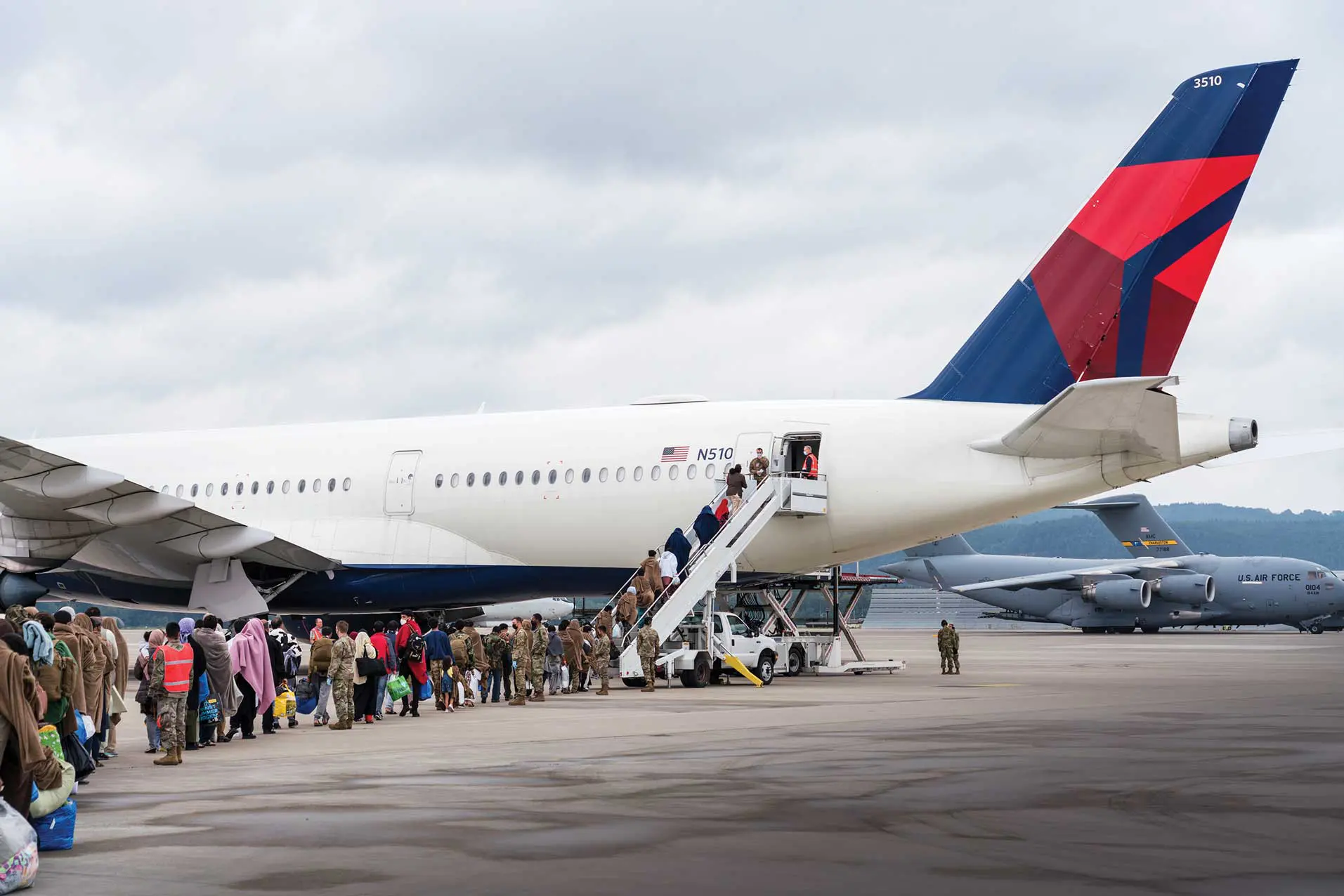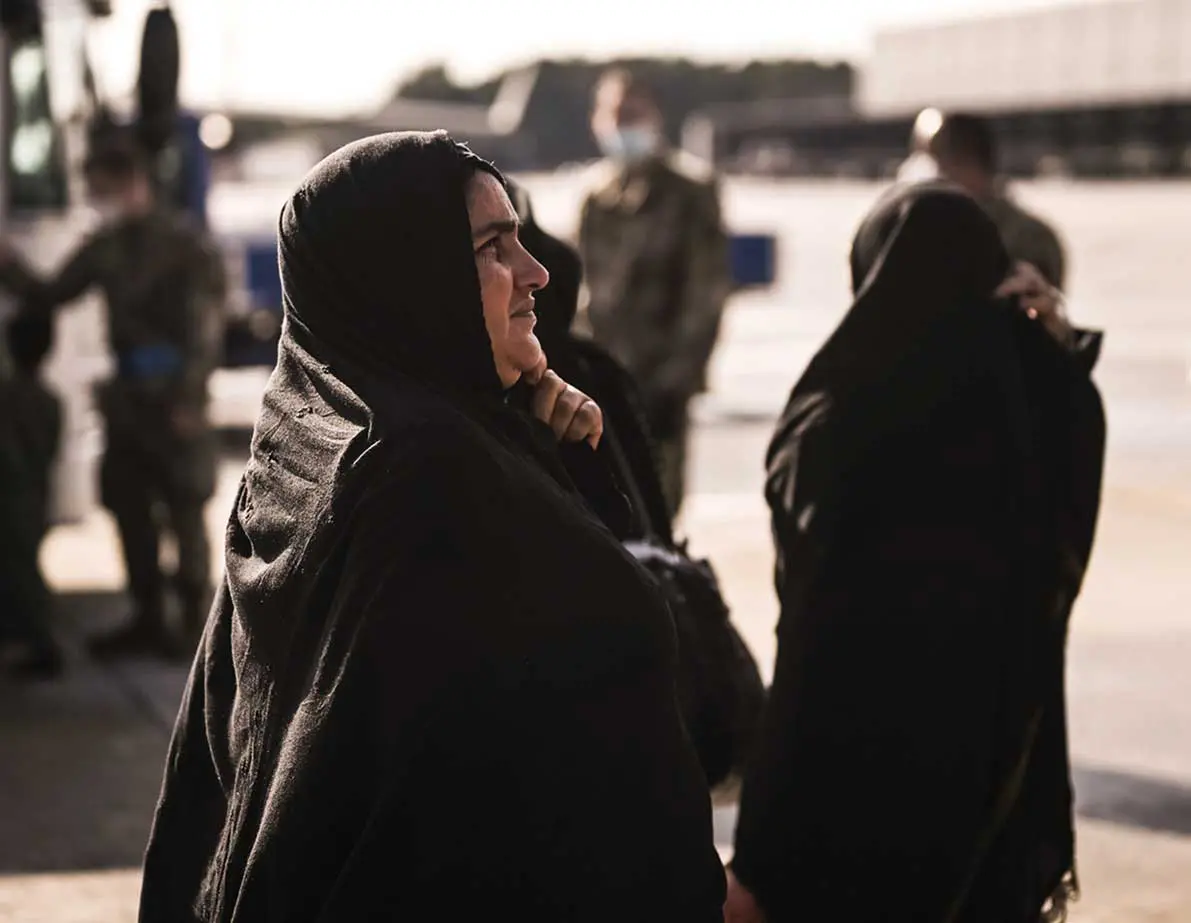Looking Back on ALLIES REFUGE
By DR. ANDREW WACKERFUSS, 521 AMOW HISTORIAN
Air mobility is rarely the most glamorous mission in the Air Force. To most outside the field, it plays a role of background support, putting people and things in place so that a higher profile mission can later succeed. Once in a generation, however, air mobility itself becomes the high-profile mission.
One year ago, the global air mobility system performed the largest airlift Noncombatant Evacuation Operation (NEO) in the Department of Defense’s (DoD) history: Operation ALLIES REFUGE (OAR) and ALLIES WELCOME, securing safe transport for nearly 124,000 travelers out of Afghanistan.
The story of the Afghanistan evacuation was told in real time across the world. Less well known are the mobility units that made it happen, such as the 521st Air Mobility Operations Wing (AMOW), which manages mobility nodes across 19 locations in U.S. Central Command (USCENTCOM), Europe, and Africa. One media article about the 521 AMOW’s role in the evacuation proclaimed, “This Air Force unit you’ve never heard of made the Afghan airlift possible.†The 18th Air Force commander, Maj Gen Kenneth T. Bibb Jr., said during a visit to 521 AMOW Airmen at Ramstein Air Base, Germany, “A lot of times as mobility Airmen we’re the offensive linemen in football. We make the holes and grind it out, so someone else can make the play. OAR is one of those times where mobility made the play.â€
From its opening in mid-August until the close of major operations at the end of October, the 521 AMOW and its partners supported the rapid deployment of the Immediate Response Force to secure Hamid Karzai International Airport (HKIA). They evacuated 84,000 civilian travelers, recovered three disabled aircraft from HKIA, generated aircraft to sustain the mission across critical nodes and to execute the Joint Tactical Exfiltration from HKIA, and supported the re-deployment of all U.S. forces out of Afghanistan.
Evacuation operations accounted for 2,080 airlift sorties spanning the DoD and the Department of State contracted airlift, aircraft donated by commercial and national partners, and the first activation of the Civil Reserve Air Fleet in 19 years. Some 85 percent of all DoD aircraft departing HKIA came through 521 AMOW stations. Because passengers traveled across multiple missions to reach their ultimate destinations, total passenger processing actions amounted to around 223,000. Units at staging bases caught missions, downloaded passengers and cargo, and worked with host installations to care for travelers. The numbers on the ground peaked at about 17,500 at Al Udeid Air Base, Qatar; 21,000 at Ramstein and Rhine Ordnance Barracks, Germany; 5,000 at Ali Al Salem Air Base, Kuwait City, Kuwait; 3,300 at Naval Air Station Sigonella, Italy; and 1,800 at Naval Station Rota, Spain.
Maintainers and controllers at Ramstein, Al Udeid, and Ali Al Salem worked nonstop to manage airflow at up to 400 percent of normal operations, with grueling conditions in Qatar and Kuwait. The 521 AMOW Airmen sanitized and restored to duty aircraft that had been soiled in unprecedented ways. Aeromedical crews at Ramstein doubled in size to conduct 28 Aeromedical Evacuation (AE) flights, delivering 14 babies. They created a new Passenger Medical Augmentation Personnel program (PMAP) that provided in-flight care for around 14,000 travelers. The 521 AMOW squadrons and stations across the theater took on passenger missions, assisted U.S. Navy partners at their stations, absorbed non-OAR airflow to clear space at key nodes, and provided resources to nodes that saw the most intense missions. By shifting 78 Airmen to crisis nodes, the 521 AMOW ensured that these stations gained the manpower they desperately needed until additional personnel could be sourced through traditional processes.
The 8th Expeditionary Air Mobility Squadron at Al Udeid, and the 5th Expeditionary Air Mobility Squadron in Kuwait, saw the worst of the initial rush of passengers and aircraft. “There were planes parked all over the entire airfield,†said SSgt Thomas Shurdich, an Air Terminal Operations Center controller who shifted from his assigned 724th Air Mobility Squadron at Aviano Air Base, Italy, to Al Udeid. “Planes were just flying around in circles in the air because there wasn’t enough room to park them on the ground. It was all over the hangars. They would operate out of pretty much any place they could park a plane and walk back to. Basically, the entire base.â€
“There were numerous medical emergencies where we had to dispatch 911,†said SSgt Michael Do, a command and control specialist the wing sent to Al Udeid. “One of the loadmasters got heat exhaustion and started vomiting, and we had to dispatch medical services. And then we had to do it again because the medical services checked him out, and he was all right, but then he turned worse again just because of the sheer heat and the amount of time that these aircrews were awake. They had the proper waivers to continue on, and they were being safe. But they were just so physically exhausted that they’d succumb to it. Calling 911 became too frequent and too easy. I hope never to have to be that comfortable calling 911 again.â€
As passengers flowed from USCENTCOM to nodes in Europe, Ramstein became overwhelmed with more travelers than it had been told it would receive.
As described by Lt Col Matthew Bryan, director of operations for the 721st Mobility Support Squadron, “The first day when they opened the floodgates for us, I was using GDSS [Global Decision Support System], and I saw these missions populate, and I started calculating how many passengers were on there. It was like over 11,000 in one day. Our max capacity that we advertised was 2,000. I called the 618th Air Operations Center and said, ‘We cannot handle this. This is way beyond anything we can handle.’ And he said, ‘This is SecDef orders. It’s happening.’ And that’s when I realized, holy smokes, this is about to get real.â€
While the host 86th Airlift Wing at Ramstein cared for the thousands of arrivals, 521 AMOW Airmen created ways to speed them off base and to their next destination. They transformed a maintenance hangar into Germany’s newest international airport, with a max through-put capacity of 5,000 per day. It was a huge effort to construct gates and screening stations, provide food and care items, and clean and service restrooms. As the commander at the time, Col Adrienne Williams, stated, “Every day our Airmen thought of something new to make this as comfortable as possible and to take care of our travelers as they were moving forward.â€
Some 34,000 passengers eventually left through this terminal. Hangar 5 was sometimes called “the happiest place on the base.†As Bryan said, “I think the travelers knew that Hangar 5 was the last point, and the next step was getting on an airplane.â€
Capt John Burdick of the 721st Aerial Port Squadron (APS), who served as a ‘hangar boss’ for the new terminal, said that it always raised morale to be directly involved with helping the travelers to the aircraft. “That was always the best part of the job,†he said.
“Any time it got really tiring or we felt someone was getting cranky, we would put them on the flight line to walk the folks to the jet, and it would just fill their cup. Never was the ‘why’ of a mission so obvious when you were there high-fiving and waving, and it was awesome.â€
Operation ALLIES REFUGE was a team effort across all 19 of the 521 AMOW locations. “Whether it was out at Al Udeid, whether it was here at Ramstein, whether it was in Sigonella, Rota, or [Royal Air Force] Mildenhall [England], the entire [521] AMOW community stepped up,†said Burdick. “We came together as a family and as a team. A lot of the Airmen saw the smiles on the travelers’ faces, and the waves and the fist bumps as everyone’s boarding the plane for the United States. You just get that inner feeling of, ‘Oh, my gosh, we’re doing something huge, and we’re saving lives, and it really matters.’â€
TSgt Justin Deaton of the 721 APS told a reporter, “I know that for me, and for a lot of my people that I work with, we joined to do things like this.â€
SrA Zion Patterson, also of the 721 APS, agreed that, despite the often terrible interior conditions of the aircraft they serviced, “It was fun for us. Usually, in fleet, we just work on restrooms, and a lot of Airmen think we’re just flushing the toilets or being a janitor. But here we got to interact with passengers. We got our hands dirty. It was stressful, but when you’re working with people you care about, and you’re going out there just jobbing, it was fun. It was interesting.â€
In the end, the 521 AMOW found itself under an unusual spotlight during this mission and together stepped up to ensure that the largest NEO airlift in history achieved its goals. As Williams said, “This event really highlights the importance of the node system for the USTRANSCOM [U.S. Transportation Command] Commander.â€
OAR showed that when regular operations suddenly become extreme, a well-maintained system with well-trained Airmen can handle a crisis as if it were routine. According to Williams:
“Our Airmen took those opportunities to succeed, and they won. They made it happen, moving all these children and families. Every opportunity that they faced to succeed, they did. Yes, there were some setbacks. Some situations where we had to work to get more water or get more food. But each time they took a step back, they took two steps forward. This is what we do in the Air Mobility Operations Wing. We move people, we take care of people, we take care of planes, we move cargo, we keep it moving through the system. And that’s what we did in OAR.â€






